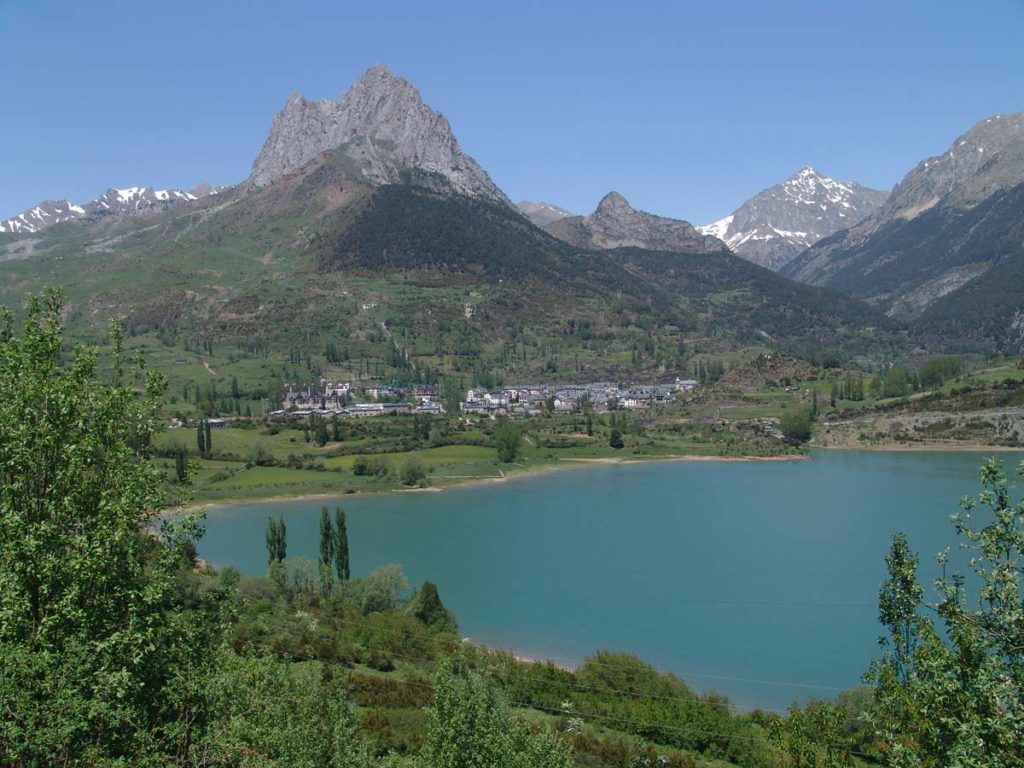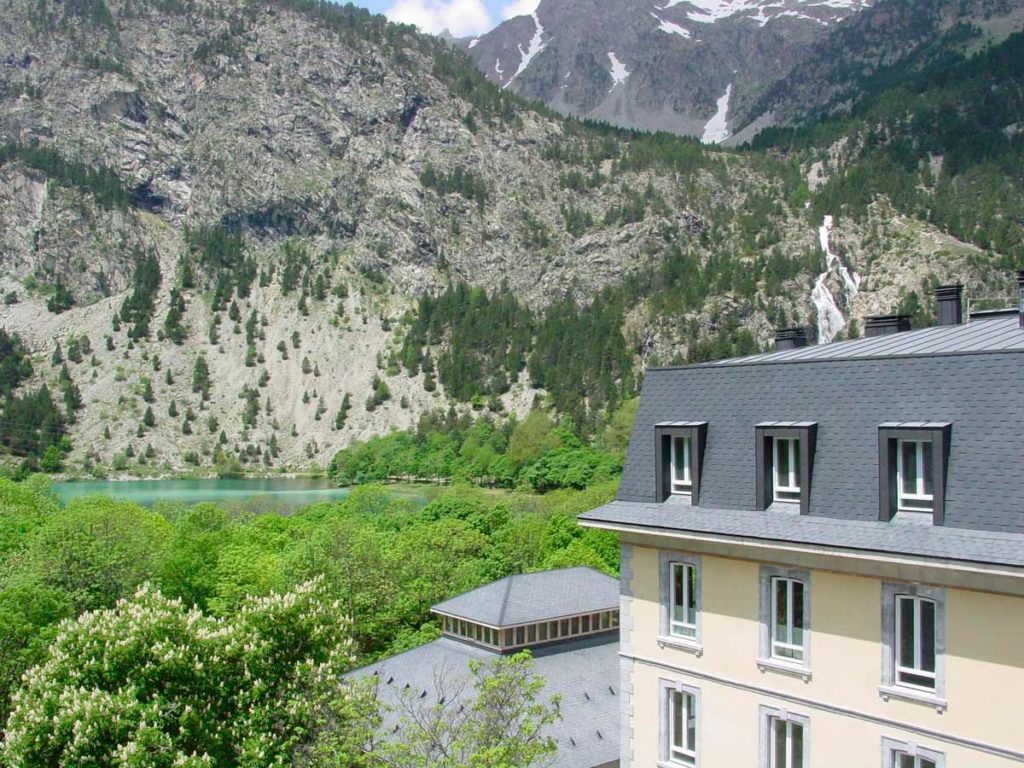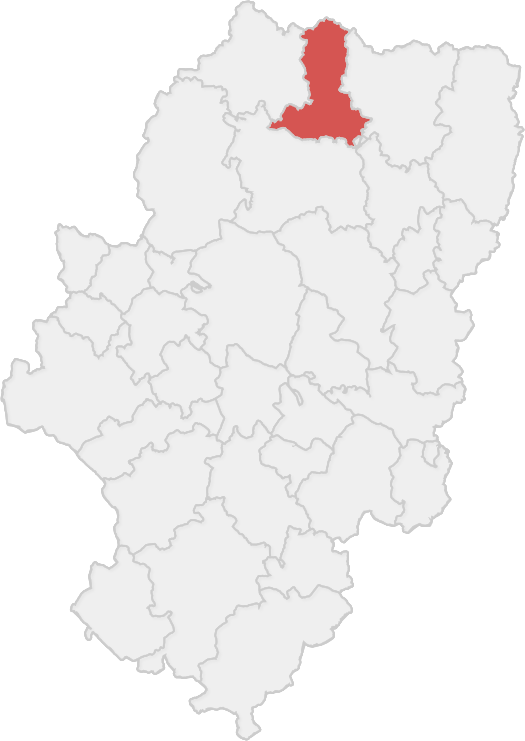Suggestive TENA Valley
For many people it is one of the most stunning places in the Aragonese Pyrenees. From its plains, to the high peaks, the Valle de Tena Valley is truly a feast for the five senses, with a never-ending sum of tourist attractions that make it one of the most impressive arteries in the Pyrenean mountain range.
Breathtaking grandeur
All its corners show an air of beathtaking grandeur while maintaining the mountainous and cosy character and welcoming that the Aragonese Pyrenees exhibits. The green of the pasture’s melts with the blue of the waters of ibones and streams. The steep landscape of the high peaks is softened as we go down to small villages with an innate magnetism where any simple detail becomes a magnificent scene.
Sallent de Gállego, at the foothills of Peña Foratata, Formigal Ski Resort, Panticosa and its chromatic contrasts, and Biescas, as entryway to the valley, are the main towns of Tena to which are added many others of such beauty.
The Pyrenean architecture, where the dark slate and the stone meet, the steep streets, the groves, bridges, fountains and nooks and crannies produce a sense of tranquillity at the same time as they serve as an excellent setting for a good number of open-air activities.
If the Pyrenees is already an interesting tourist destination, the Tena Valley lends itself to increase this conception that makes it one of the most attractive places in the whole Aragonese community.
An unexpected tour of the Bal De Tena

Cross the Valle de Tena, usually, has been made by its main route of communication, the A-136 that runs from Biescas to Sallent de Gállego passing through the reservoir of Búbal and the swamp of Lanuza. But there are other alternatives, two of them less crowded to discover other points of view.
A few kilometres from Biescas, considered as the access of the valley, we reached Búbal´s dam. At this point our journey is out of the common route. We take the road towards Hoz de Jaca and cross the dam and begin to go up to this tiny town. The journey takes just just three kilometres.
Once in Hoz, take your time to make a stop, gape and enjoy one of the best views of the whole valley from the viewpoint, at the exit of the village.
We take the route along the only road that follows nearby to the right bank of the reservoir until you reach the Pueyo de Jaca, one of the municipalities that is experiencing the greatest growth. There you can visit the Church of San Miguel (16th century), have delicious “Sopetas” at the terrace bar of the reservoir or just having a rest on the margin of Búbal or river Caldarés.
From the Pueyo of Jaca, if we go right, we arrive, on foot or by car, until Panticosa or by contrast if we go left, we get Escarrilla. The most adventurous can out hiking to the peak of Cochata which sits in the middle of the valley with great views in all directions. Although not high it’s quite a rocky peak and looks as if it’s hard to climb but there’s a fairly easy route to the summit. The rest can enjoy sightseeing.
In Escarrilla the rivers Escarilla and Gallego converge and it immediately opens the reservoir Lanuza. At this point we get back out of the usual route.
We can get well to Sallent de Gallego by road or by the paths that borders the swamp. It is recommended to amble around and enjoy the silent streets of desert village of Lanuza.
From there we arrived to Sallent.
Sallent de Gállego: The visible head of the Valley
One of the most important towns of Tena is Sallent de Gállego, located in the tail of the reservoir of Lanuza and under the foothill of the Peña Foratata. Its church is gothic style (dated XV) has an imposing altarpiece a magnificent example of the Plateresque style, the Roman bridge and its nearby playground, the triple Romanesque arch of the square and the wide range of services, make Sallent a highly recommended place to spend a holiday. Summer, winter, all seasons are great to find a myriad of options that include; excursions, a great range of flora and fauna, sports activities by land, sea and air, festivals and popular festivals. Can you ask for more?
Resume the way back
Sallent is the last village before reaching Formigal from where to get, cross the border by the Portalet. But to return to Biescas avoiding the A-136, another alternative is to take the road that crosses the towns of Sandiniés, Tramacastilla and Piedrafita and converging in the reservoir of Búbal.
From these three locations, there are many paths that stand out because of their accessibility and their little difficulty. They are very recommended for the whole family, especially the one that arrives from Escarrilla to the point Cochata, which ends in the forest of Betato-Piedrafita that comes out from Tramacastilla. Another alternative is the one that departs in Piedrafita and arrives to the Ibón of Piedrafita. Besides, an additional recommended trail is the one that unites these three beautiful towns by means of a path with reasonable slopes and astonishing views.
Discovering the architectural richness of these places, sitting at the tables of their pleasant restaurants or doing many outdoor activities. They are some of the proposals suggested by this part of the Valle de Tena.
Nature and Wildlife in Lacuniacha
Lacuniacha is a new leisure resort that matches other activities that can be done within the unique landscape of Valle de Tena placed in central Pyrenees, in Aragon, province of Huesca. Both in winter and summer, Lacuniacha provides a pleasant reminder to all the people who enjoy their leisure time. It is an activity suitable for all ages.
It occupies an area of thirty hectares and is in the municipality of Piedrafita de Jaca, two kilometres from its urban center. It can be easily reached by car to the entrance, where it has a large parking area for cars and buses. It is not a zoo or a theme park, it is a woodland. The estimated time to visit it properly Is around two and three hours, so it is thought to enjoy a one-day excursion. There, there are available rest areas where you can buy hot and cold snacks, sodas, coffee, ice cream or eat your own food.
The route is well signposted. It pleasantly surprises the beauty of the forest, the discovery of a wildlife, which inhabit the Pyrenees for thousands of years ago. Throughout the visit and to discover the animals in their habitat, an active participation is needed. It provides a special joy when you contemplate your habits and actions in a natural environment.
The walking distance is around five kilometers, the total height of 180 Meters. Deer, roe deer, deer, reindeer, wild goat, sarrios, European bison, Northern lynx, wolves and horses of Przewalski, can be seen by following the tracks and you also can see how they feed, rest, interact between them, care for their babies or simply play.
You can also appreciate the flora, learning to distinguish between pines, thorns, beech trees, birch, ash, cerecedas, oak groves, malls, holly and contemplate their meadows and the charm of the mixed forest of the Pyrenees.
There are viewpoints with informative boards with some information about the hugeness of the peaks and mountain changes that surround Lacuniacha.
Lacuniacha opens all year round, offering to the visitor different activities according to the time, allowing visitors to enjoy both in summer and in winter of an exclusive landscape.
Useful tips for the visit:
The route is made through natural mountain trails, not paved. It is recommended to wear suitable footwear for mountain such as mountain boots or sports shoes. For wheelchair users, the great outdoors can often be a no-go, because facilities described are not accessible. In case of pushchair users, it is advisable to use a baby carrier backpack. You can rent it at the park reception.
The park is located between 1,380 and 1,580 meters of altitude, and all the route is made outdoors. nature is unpredictable so, planning ahead can be the key to a fun and safe adventure. Keep up with the weather forecast. It is important to understand the weather patterns and conditions of this new environment and be weather-ready before you go. Weather conditions can quickly change. Keep a ‘weather eye’ on the sky and carry all you need outerwear, raincoat, sun cream.
Enjoy the opportunity to get a unique experience, do not track the tour hurriedly, breath deeply, stop to listen birdsongs, advance quietly to discover the animals before they discover you, observe the beauty of the landscape, of the trees, of the flowers.
Panticosa

Panticosa, or Panticuto in Aragonese, it has been until a few years ago one of those small villages of the quiet and picturesque Pyrenees whose name had been shouted from the rooftops, because of its thermal spa resort. But nowadays, Panticosa grows rapidly without losing that calm and representative character. Its urban center expands rapidly at the same rate as the services of the tourist demand. All this makes this beautiful town “Tensina” (called villages from Valle de Tena) in one of the most advisable places to enjoy a second home, a holiday or just occasional walks.
In the urban complex, there are classical architecture remnants dating back of the nineteenth century. It was during the decade of 1860 to 1870 when the spa of Panticosa acquires its golden age. This is proved trough the large farmhouses and noble houses.
The Church of La Asunción stands out. It was designated a historical-artistic monument and was built in the 16th century under an evident late Gothic character. There is no need to lose any detail of the main altarpiece, the choir and the showcases that display the parish’s books and treasures. Another of the churches, the old parish of San Salvador is today the hermitage of the cemetery and preserves two medieval monograms (Crisones) on its southern wall. In addition to temples, Panticosa shows a magnificent bridge over the Caldarés river, which is located under the chairlift of the ski resort. It was built in 1,556 by Beltrán de Betbedé, who also made the vaults of the Church of Sallent de Gállego.
But in addition to this architectural display, Panticosa has other innate charms all over the year. The surrounding area of Panticosa is a marvelous spectacle. Starting with the numerous peaks that exceed the 3000 meters of altitude, until reaching its long tradition ski resort, its surroundings offer infinitive of alternatives to spend a few days in the middle of nature. No matter which season you choose to visit it, you will not be disappointed as each season brings its own distinct flavor. It is always active.
Find the best views
Many corners of the valley offer superb views that delight and seduce the traveler. In most of these strategic points, viewpoints have been established which, through informative boards, help to know the natural elements that shape the valley.
In Sallent de Gállego there are three viewpoints of this type and offer remarkable panoramic views; They are “St. Mamas”, “El Salto” and “La Sierra”. But the list doesn’t end here. Those of “San Salvador” and “Río Gállego” in Biescas, the “Hoz of Jaca, “El Saldo de Escarra” in Escarrilla, are other breathtaking viewpoints of the Valle de Tena.
In Panticosa there are three, one in “Santa Maria” village and two more in the spa resort, “de la Reina” and “Del Pino”. To access these two, you must ascend a small path that is part of the back of the spa. It is just behind the shelter of the stone house, in just 5 minutes’ walk.
Splendor in the spa of Panticosa

The Baths of Panticosa became, throughout the nineteenth century, in one of the largest and most prestigious spas as a thermal villa accomplished to accommodate more than one thousand five hundred people. Its offer of accommodation was even greater than the known placed in Santander or San Sebastian.
Today it maintains this vintage flavor. Even though its facilities were fully refurbished. After having brought in the latest techniques and thermal appliances into their bathrooms, the thermal spa resort offers curative procedures, ranging from pressure jets to inhalations, baths, showers and bathtubs, among others. Their water´s properties are indicated for renal failure, digestive, respiratory, obesity and skin, rheumatic and nervous conditions.
The thermal resort services also include restaurants, casino, tennis court, swimming pools, bars and shops.
Activities around the Thermal Resort
The activity and entertainment department of Panticosa Thermal Resort advises and plans different leisure activities that take place in the surrounding area. Besides hiking, climbing, river rafting, diving or excursions, they inform about other fun activities such as music shows, concerts and performances. In short, a world of suggestions to enjoy in the heart of nature.
The essence of Tena and its valley
“The kitchen is dynamic and is developed on many occasions by foreign impulses caused by the products previously unavailable and for which the local cuisine does not have recipes. The Pyrenees Huesca, as being a tourist destination, has had to adapt it to the new demands, while preserving, also with greater or lesser fortune, its own tradition. ” This statement made in the year 1995 by the journalist specializing in gastronomy José Manuel Porquet It’s perfectly up to date. Let us see in a brief synthesis if it really exists and what is that tradition of the Pyrenean valleys.
Many thinks, as Porquet or Lorenzo Acín do, that the gastronomy of the mountain was the one that gave consistency and was the base of the rest of the traditional. And it seems that, to some extend they were right. Studies confirm some issues. For example, at the beginning of the 11th and 12th centuries the Aragonese diet was extraordinarily limited: bread, wine and oil formed the basis of food. This was added beef, pork, lamb and hunting, such as wild boars and deer, milk and cheese, fish from the Pyrenean rivers and some vegetables. Pepper and salt as a condiment, and honey to sweeten. And that was it. This is what the historian Manuel Gómez de Valenzuela says in his work of 1978 food, cuisine and gastronomy in Aragon in the 11th and 12th centuries.
Advancing in time and always based on the most forceful studies on food in the upper Aragon, it is observed that as far as vegetables are concerned, they already ate onions, garlic, peppers, spinach, peas, beans or chickpeas. As for oil it was not until the 12th century when they began to produce it in the Valle del Aragón. Until then or was imported or cooked with animal fats.
Gastronomy
The Valle de Tena has a brilliant gastronomic showcase provided by the huge number of catering establishments that are dealt for all its geographical delimitation. Without much sophistication, but with good results, the restaurants enhance added value to their cuisine with their ambience and distinctive mountain decor.
One of the offers that leads in all of them is the daily special. As a rule, it is better to request this type of menus that, at very affordable and reasonable prices, lend discover a very similar kitchen line in all the restaurants, but very well resolved.
In any of these places do not miss out ordering “Patatas encebollados” (potatoes in onions), grilled meats, “Olla Tensina” (a stew to pick on a cold winter day) or mouthwatering “sopetas” (soups).
Adventure and Extreme Sports
Most of the peaks that exceed the three thousand meters of altitude of the Aragonese Pyrenees, are in this valley. Departing from the Panticosa Thermal Resort many routes lead to peaks such us the Garmo Negro, Argualas or the Picos del Infierno. The reservoir of La Sarra, which is accessed by road from Sallent de Gállego, is the starting point to reach the Balaitous, one of the most frequented by its beauty and difficulty at the same time. And to spend the night, nearby, you find the Respumoso shelter, next to the Ibón of the same name, or La Casa de Piedra in Panticosa spa resort.
Rivers, mainly Gállego River, allow to practice many extreme sports like rafting or canyoning. Fast-flowing and frothing waters running over huge rocks and through tight gorges can quickly become addictive. Although another less daring alternative is sailing in the reservoir of Búbal in small sailboats. Horseback riding through La Partacua, go down mountain biking on the ski slopes of Panticosa or climbing to the Sallent wall are other options offered in the valley.
For kids

The Panticosa Los Lagos ski Resort is turned during the summer months into one of the most suggested spaces for kids. It is opened in summer to offer some activities. It is a perfect plan to enjoy a family day out surrounding by the most striking landscapes of the valley. Visitors can take the chairlift to the height 1900 and approaching the ibones of Asses and Sabocos.
A thrilling adventure with children is found on the many routes that run through the valley. They discover the most abundant flora and fauna. With a bit of luck, you can see “Sarrios”, roe deer, squirrels and other species. Those that depart from the Panticosa Spa Resort towards the Ibones of Bachimaña or Bramatuero (lakes), and those that border the arch of Piedrafita are highly recommended to initiate children in nature. One last recommendation: Don’t forget to bring the camera.
Popular festivities, pilgrimages and flea markets
July and August are the months in which, almost all the towns of the Tena Valley celebrate their most lively festivities.
The festive calendar begins on June 11th in Biescas where the pilgrimage that starts from this village arrives to the hermitage of Santa Elena. There meet the inhabitants of many of the towns of Tena and the Serrablo. Another of the most attractive celebrations is the one that takes place in Sabiñánigo on the 25th of July and that tends to concentrate to a large audience.
The first fortnight of July, on the 6th and 7th, Panticosa is looking back to celebrate the medieval market. Shows, handicrafts and food in an atmosphere of jesters and minstrels. Highly recommended.
Already full in August Sallent de Gállego is the first to celebrate its festivities in honor of the Virgen de Las Nieves Saint on day 5th. And just the day that concludes these, begin the Formigal. Hoz de Jaca, in Honor of San Lorenzo, begins its festivities on the 10th of the same month.
But it is around the 15th day when many areas start their most special celebrations. This is the case of Panticosa, Piedrafita and Biescas. Five days later, are held the Lanuza dedicated to Saint Joaquin, the 24th the town of Gavin and later Sandiniés, day 25th, and the Pueyo de Jaca helds from the 27th of August.



